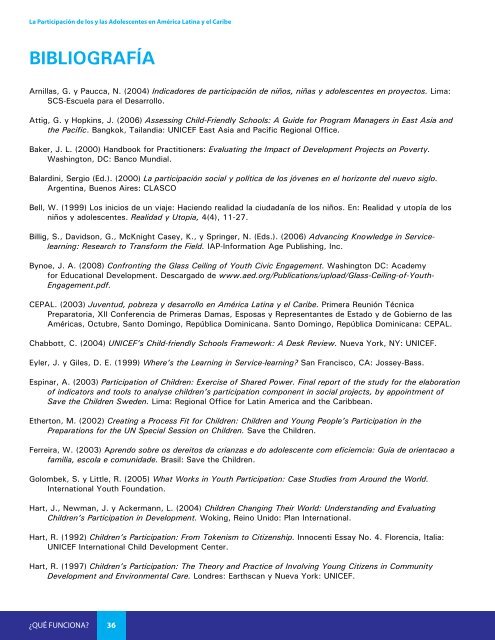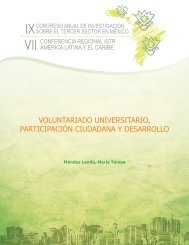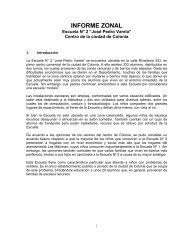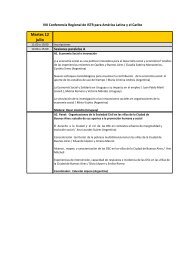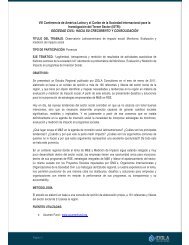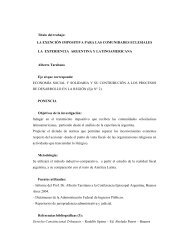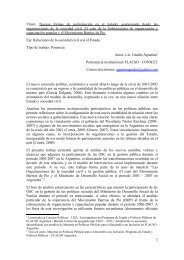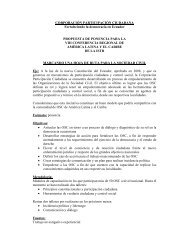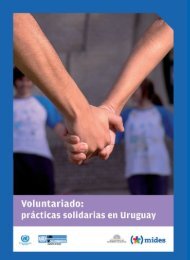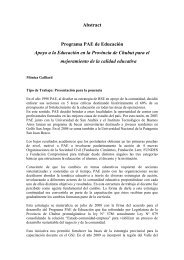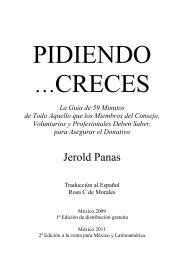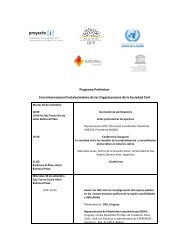¿QUÉ FUNCIONA? - Unicef
¿QUÉ FUNCIONA? - Unicef
¿QUÉ FUNCIONA? - Unicef
Create successful ePaper yourself
Turn your PDF publications into a flip-book with our unique Google optimized e-Paper software.
La Participación de los y las Adolescentes en América Latina y el Caribe<br />
BIBLIOGRAFÍA<br />
Arnillas, G. y Paucca, N. (2004) Indicadores de participación de niños, niñas y adolescentes en proyectos. Lima:<br />
SCS-Escuela para el Desarrollo.<br />
Attig, G. y Hopkins, J. (2006) Assessing Child-Friendly Schools: A Guide for Program Managers in East Asia and<br />
the Pacific. Bangkok, Tailandia: UNICEF East Asia and Pacific Regional Office.<br />
Baker, J. L. (2000) Handbook for Practitioners: Evaluating the Impact of Development Projects on Poverty.<br />
Washington, DC: Banco Mundial.<br />
Balardini, Sergio (Ed.). (2000) La participación social y política de los jóvenes en el horizonte del nuevo siglo.<br />
Argentina, Buenos Aires: CLASCO<br />
Bell, W. (1999) Los inicios de un viaje: Haciendo realidad la ciudadanía de los niños. En: Realidad y utopía de los<br />
niños y adolescentes. Realidad y Utopia, 4(4), 11-27.<br />
Billig, S., Davidson, G., McKnight Casey, K., y Springer, N. (Eds.). (2006) Advancing Knowledge in Servicelearning:<br />
Research to Transform the Field. IAP-Information Age Publishing, Inc.<br />
Bynoe, J. A. (2008) Confronting the Glass Ceiling of Youth Civic Engagement. Washington DC: Academy<br />
for Educational Development. Descargado de www.aed.org/Publications/upload/Glass-Ceiling-of-Youth-<br />
Engagement.pdf.<br />
CEPAL. (2003) Juventud, pobreza y desarrollo en América Latina y el Caribe. Primera Reunión Técnica<br />
Preparatoria, XII Conferencia de Primeras Damas, Esposas y Representantes de Estado y de Gobierno de las<br />
Américas, Octubre, Santo Domingo, República Dominicana. Santo Domingo, República Dominicana: CEPAL.<br />
Chabbott, C. (2004) UNICEF’s Child-friendly Schools Framework: A Desk Review. Nueva York, NY: UNICEF.<br />
Eyler, J. y Giles, D. E. (1999) Where’s the Learning in Service-learning? San Francisco, CA: Jossey-Bass.<br />
Espinar, A. (2003) Participation of Children: Exercise of Shared Power. Final report of the study for the elaboration<br />
of indicators and tools to analyse children’s participation component in social projects, by appointment of<br />
Save the Children Sweden. Lima: Regional Office for Latin America and the Caribbean.<br />
Etherton, M. (2002) Creating a Process Fit for Children: Children and Young People’s Participation in the<br />
Preparations for the UN Special Session on Children. Save the Children.<br />
Ferreira, W. (2003) Aprendo sobre os dereitos da crianzas e do adolescente com eficiemcia: Guia de orientacao a<br />
familia, escola e comunidade. Brasil: Save the Children.<br />
Golombek, S. y Little, R. (2005) What Works in Youth Participation: Case Studies from Around the World.<br />
International Youth Foundation.<br />
Hart, J., Newman, J. y Ackermann, L. (2004) Children Changing Their World: Understanding and Evaluating<br />
Children’s Participation in Development. Woking, Reino Unido: Plan International.<br />
Hart, R. (1992) Children’s Participation: From Tokenism to Citizenship. Innocenti Essay No. 4. Florencia, Italia:<br />
UNICEF International Child Development Center.<br />
Hart, R. (1997) Children’s Participation: The Theory and Practice of Involving Young Citizens in Community<br />
Development and Environmental Care. Londres: Earthscan y Nueva York: UNICEF.<br />
<strong>¿QUÉ</strong> <strong>FUNCIONA</strong>? 36


